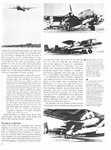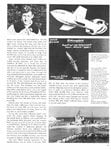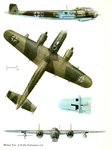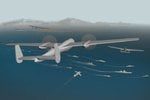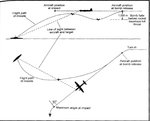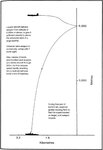Erich
the old Sage
Guys have we started a thread on this yet ? maybe some interesting debate will develop. heres a short article and some links to get us in the chatting mood...
Several new German weapons made their debuts during SHINGLE. The "Fritz X" guided missile had already been introduced during the Salerno campaign but it was now being used more extensively. This rokket was primarily an anti-ship weapon. In a sense, it was the precursor of today's cruise missile. It had fins so it was designed to glide rather than drop and was radio-controlled from the launching aircraft. Fritz had an armor-piercing warhead with 320 kilograms of amatol, which surrounded a set of central explosive tubes. It had a range of nearly four miles and a speed of 600 mph. But the radio-controlling feature which made it so effective turned out to be its Achilles heel. Its reliability depended on a radio beam, but this could be detected and jammed. The U.S. and British navies quickly equipped three destroyer escorts with jamming devices and the early-warning equipment was so efficient that it could detect the German bombers on the runway just outside of Rome before their takeoff. Then a desperate game of cat-and-mouse ensued, with the bomber pilot trying to keep his glider bomb on target while the destroyermen fought to stay on the beam to direct the bomb away from the target. They weren't always successful. On 23 January a bomb evaded the defenses and hit the British destroyer JANUS. She went down in 20 minutes with the loss of her captain and over 150 men."
"The next day, as the fleet passed through the Straits of Bonafacio, which separate Corsica from Sardinia, it was attacked by 11 Do-217s Fritz-X glide bombs. The bombers concentrated their attacks on the large modern battleships ROMA and ITALIA. The ROMA was hit twice, bringing it dead in the water while fires raged below decks. Twenty minutes after the first hit, the fires reached the ROMA's magazines, the resulting explosion breaking the ship in half. It folded up and sank with most of her crew. The ITALIA was hit by a single Fritz-X, but although the battleship took on water, it managed to limp to Malta. "
http://www.vectorsite.net/twbomb3.html
"That same day, the Allies landed on the beach at Salerno to begin their movement into Italy. The Luftwaffe responded with a week of glide bomb attacks, badly damaging the battleship HMS WARSPITE, the cruisers HMS UGANDA and the USS SAVANNAH, and sinking or damaging several other lesser vessels. The WARSPITE was hit by three Fritz-X bombs, one of which penetrated six decks and blew a hole in the ship's bottom. The ship took on a good deal of water and was completely disabled, but fires didn't break out and casualties were only 9 dead and 14 wounded, blessedly light for so devastating an attack. The battleship was towed away and did not return to action until June 1944. "
Conclusion.
"A translation of a Luftwaffe report on the operational use of guided missiles by KG 100 listed a total of 65 operations with 487 aircraft (both Fritz X and Hs.293). A total of 500 rounds were carried, but a number were lost with their aircraft, or returned to base. At the target, 319 bombs were dropped, of which 215 correctly functioned, with a 49.3% hit rate. "
"In all, 79 enemy naval units, including 40 warships and 39 merchant ships of a gross registered tonnage of 291,000 tons were either partially or totally put out of action, for the loss of 48 aircraft. "
"The greatest proportion of lost operations was due to unfavourable conditions at the target, with technical failures much lower (only 7.5% due to trouble with the remote control system)."
"Luftwaffe operations with the Hs.293 at the beginning of the campaign were successful due to two main factors. Firstly the crews were well trained and experienced. Secondly, the weapon was novel and the allies were not prepared with counter measures. With attrition of the longer term bomber crews the success rate fell. However, the effect of allied fighter superiority had a large effect on weapon accuracy. Daylight fighter superiority forced the bombers to fly at night making the effective identification of targets and accurate tracking of the weapons very difficult. In addition the presence of fighters must have made it difficult for the bombers to keep a steady course for the bomb aimers to keep the missiles in view all the way to the target. "
"The Luftwaffe was also very lax in not testing the frequency band of the control signals of the missiles for jamming signals. Once launched, jammed missiles would appear to the operator to launch and fly towards the target but the reason for failing to impact accurately might not be apparant, and it seems from the report that the Luftwaffe had no idea that the control signals were not being received. "
"The Luftwaffe was critical of the choice of target and the choice of operational conditions which made the weapon less effective. Developments were in hand to improve the motor of the Hs.293 giving it more power, making it faster to target, and improvements in control systems were appearing all the time - but arrived too late for the Hs.293 to make any further operational impact."
http://www.walter-rockets.i12.com/missiles/hs293b.htm
"The success of the Allies in jamming the Kehl-Strassburg system led to the "Hs-293B", which featured the "Dortmund-Duisburg" wire guidance system. The Hs-293B had a range of range of 30 kilometers (19 miles), with wire spooling out from both the bomb and the launch aircraft. 200 Hs-293Bs were rebuilt from Hs-293A production, and were used in limited numbers in the Mediterranean by bombers flying from northern Italy at the end of the war.
Hitler had ordered that the glide bombs not be used against land targets, in fear that the Allies might be able to recover a dud and learn the secrets of the technology. With the Allies closing in, the order was lifted, and in April 1945, Hs-293Bs were used on attacks on bridges over the river Oder in hopes of slowing down the Soviet advance on Berlin."
Several new German weapons made their debuts during SHINGLE. The "Fritz X" guided missile had already been introduced during the Salerno campaign but it was now being used more extensively. This rokket was primarily an anti-ship weapon. In a sense, it was the precursor of today's cruise missile. It had fins so it was designed to glide rather than drop and was radio-controlled from the launching aircraft. Fritz had an armor-piercing warhead with 320 kilograms of amatol, which surrounded a set of central explosive tubes. It had a range of nearly four miles and a speed of 600 mph. But the radio-controlling feature which made it so effective turned out to be its Achilles heel. Its reliability depended on a radio beam, but this could be detected and jammed. The U.S. and British navies quickly equipped three destroyer escorts with jamming devices and the early-warning equipment was so efficient that it could detect the German bombers on the runway just outside of Rome before their takeoff. Then a desperate game of cat-and-mouse ensued, with the bomber pilot trying to keep his glider bomb on target while the destroyermen fought to stay on the beam to direct the bomb away from the target. They weren't always successful. On 23 January a bomb evaded the defenses and hit the British destroyer JANUS. She went down in 20 minutes with the loss of her captain and over 150 men."
"The next day, as the fleet passed through the Straits of Bonafacio, which separate Corsica from Sardinia, it was attacked by 11 Do-217s Fritz-X glide bombs. The bombers concentrated their attacks on the large modern battleships ROMA and ITALIA. The ROMA was hit twice, bringing it dead in the water while fires raged below decks. Twenty minutes after the first hit, the fires reached the ROMA's magazines, the resulting explosion breaking the ship in half. It folded up and sank with most of her crew. The ITALIA was hit by a single Fritz-X, but although the battleship took on water, it managed to limp to Malta. "
http://www.vectorsite.net/twbomb3.html
"That same day, the Allies landed on the beach at Salerno to begin their movement into Italy. The Luftwaffe responded with a week of glide bomb attacks, badly damaging the battleship HMS WARSPITE, the cruisers HMS UGANDA and the USS SAVANNAH, and sinking or damaging several other lesser vessels. The WARSPITE was hit by three Fritz-X bombs, one of which penetrated six decks and blew a hole in the ship's bottom. The ship took on a good deal of water and was completely disabled, but fires didn't break out and casualties were only 9 dead and 14 wounded, blessedly light for so devastating an attack. The battleship was towed away and did not return to action until June 1944. "
Conclusion.
"A translation of a Luftwaffe report on the operational use of guided missiles by KG 100 listed a total of 65 operations with 487 aircraft (both Fritz X and Hs.293). A total of 500 rounds were carried, but a number were lost with their aircraft, or returned to base. At the target, 319 bombs were dropped, of which 215 correctly functioned, with a 49.3% hit rate. "
"In all, 79 enemy naval units, including 40 warships and 39 merchant ships of a gross registered tonnage of 291,000 tons were either partially or totally put out of action, for the loss of 48 aircraft. "
"The greatest proportion of lost operations was due to unfavourable conditions at the target, with technical failures much lower (only 7.5% due to trouble with the remote control system)."
"Luftwaffe operations with the Hs.293 at the beginning of the campaign were successful due to two main factors. Firstly the crews were well trained and experienced. Secondly, the weapon was novel and the allies were not prepared with counter measures. With attrition of the longer term bomber crews the success rate fell. However, the effect of allied fighter superiority had a large effect on weapon accuracy. Daylight fighter superiority forced the bombers to fly at night making the effective identification of targets and accurate tracking of the weapons very difficult. In addition the presence of fighters must have made it difficult for the bombers to keep a steady course for the bomb aimers to keep the missiles in view all the way to the target. "
"The Luftwaffe was also very lax in not testing the frequency band of the control signals of the missiles for jamming signals. Once launched, jammed missiles would appear to the operator to launch and fly towards the target but the reason for failing to impact accurately might not be apparant, and it seems from the report that the Luftwaffe had no idea that the control signals were not being received. "
"The Luftwaffe was critical of the choice of target and the choice of operational conditions which made the weapon less effective. Developments were in hand to improve the motor of the Hs.293 giving it more power, making it faster to target, and improvements in control systems were appearing all the time - but arrived too late for the Hs.293 to make any further operational impact."
http://www.walter-rockets.i12.com/missiles/hs293b.htm
"The success of the Allies in jamming the Kehl-Strassburg system led to the "Hs-293B", which featured the "Dortmund-Duisburg" wire guidance system. The Hs-293B had a range of range of 30 kilometers (19 miles), with wire spooling out from both the bomb and the launch aircraft. 200 Hs-293Bs were rebuilt from Hs-293A production, and were used in limited numbers in the Mediterranean by bombers flying from northern Italy at the end of the war.
Hitler had ordered that the glide bombs not be used against land targets, in fear that the Allies might be able to recover a dud and learn the secrets of the technology. With the Allies closing in, the order was lifted, and in April 1945, Hs-293Bs were used on attacks on bridges over the river Oder in hopes of slowing down the Soviet advance on Berlin."

